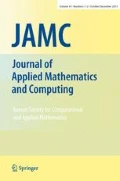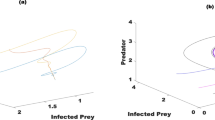Abstract
In this paper, a fractional order eco-epidemiological model with nonlinear incidence rate is studied. The populations are divided into healthy prey, infected prey and predator. A prey refuge was introduced in the healthy prey population to make the model more realistic. Various qualitative properties including local and global stability analysis of equilibrium points are investigated. The theoretical results are verified by numerical simulations. The fractional order model is shown to have rich dynamical behavior including bistability phenomena, supercritical Hopf bifurcation, subcritical Hopf bifurcation and transcritical bifurcation.
















Similar content being viewed by others
Data Availability Statement
Not applicable.
References
Bacaër, N.: A short history of mathematical population dynamics. Springer Science & Business Media, Berlin (2011)
Chen, Y., Jiang, Y.: An eco-epidemiological model with infectious disease in food chain. Int. J. Bifurc. Chaos 21, 1935–1952 (2011)
Biswas, S., Sasmal, S.K., Samanta, S., Saifuddin, M., Pal, N., Chattopadhyay, J.: Optimal harvesting and complex dynamics in a delayed eco-epidemiological model with weak Allee effects. Nonlinear Dyn. 87, 1553–1573 (2017)
Saifuddin, M., Sasmal, S.K., Biswas, S., Sarkar, S., Alquran, M., Chattopadhyay, J.: Effect of emergent carrying capacity in an eco-epidemiological system. Math. Methods Appl. Sci. 39, 806–823 (2016)
Sharma, S., Samanta, G.P.: A Leslie-Gower predator-prey model with disease in prey incorporating a prey refuge. Chaos Solitons Fractals 70, 69–84 (2015)
Mortoja, G., Panja, P., Mondal, K.: Dynamics of a predator-prey model with nonlinear incidence rate, Crowley-Martin type functional response and disease in prey population. Ecol. Genet. Genom. 10, 100035 (2018)
Meng, X., Qin, N., Huo, H.: Dynamics analysis of a predator-prey system with harvesting prey and disease in prey species. Journal of Biological Dynamics 12, 342–374 (2018)
Moustafa, M., Mohd, M.H., Ismail, A.I., Abdullah, F.A.: Dynamical analysis of a fractional-order eco-epidemiological model with disease in prey population. Adv. Diff. Equ. 2020, 48 (2020)
Shaikh, A.A., Das, H., Sarwardi, S.: Dynamics of an eco-epidemiological system with disease in competitive prey species. J. Appl. Math. Comput. 1, 1–21 (2019)
Bulai, I.M., Hilker, F.M.: Eco-epidemiological interactions with predator interference and infection. Theor. Popul. Biol. 130, 191–202 (2019)
Mondal, A., Pal, A.K., Samanta, G.P.: Analysis of a delayed eco-epidemiological pest-plant model with infected pest. Biophys. Rev. Lett. 14, 141–170 (2019)
Juneja, N., Agnihotri, K.: Global stability of harvested prey–predator model with infection in predator species, In: Information and Decision Sciences, Springer, pp. 559–568 (2018)
Biswas, S., Samanta, S., Chattopadhyay, J.: A cannibalistic eco-epidemiological model with disease in predator population. J. Appl. Math. Comput. 1, 1–37 (2018)
Maiti, A.P., Jana, C., Maiti, D.K.: A delayed eco-epidemiological model with nonlinear incidence rate and Crowley-Martin functional response for infected prey and predator. Nonlinear Dyn. 1, 1–31 (2019)
Hsieh, Y., Hsiao, C.: Predator-prey model with disease infection in both populations. Math. Med. Biol. J. IMA 25, 247–266 (2008)
Gao, X., Pan, Q., He, M., Kang, Y.: A predator-prey model with diseases in both prey and predator. Phys. A Stat. Mech. Appl. 392, 5898–5906 (2013)
Zhou, X., Cui, J.: Stability and Hopf bifurcation of a delay eco-epidemiological model with nonlinear incidence rate. Math. Model. Anal. 15, 547–569 (2010)
Saifuddin, M., Biswas, S., Samanta, S., Sarkar, S., Chattopadhyay, J.: Complex dynamics of an eco-epidemiological model with different competition coefficients and weak Allee in the predator. Chaos Solitons Fractals 91, 270–285 (2016)
Saha, S., Maiti, A., Samanta, G.P.: A Michaelis-Menten predator-prey model with strong Allee effect and disease in prey incorporating prey refuge. Int. J. Bifurc. Chaos 28, 1850073 (2018)
Peng, M., Zhang, Z., Lim, C.W., Wang, X.: Hopf bifurcation and hybrid control of a delayed ecoepidemiological model with nonlinear incidence rate and Holling type II functional response. Math. Prob. Eng. 1, 1–6 (2018)
González-Olivares, E., Ramos-Jiliberto, R.: Dynamic consequences of prey refuges in a simple model system: more prey, fewer predators and enhanced stability. Ecol. Model. 166, 135–146 (2003)
Pal, A.K., Samanta, G.P.: Stability analysis of an eco-epidemiological model incorporating a prey refuge. Nonlinear Anal. Model. Control 15, 473–491 (2010)
Kant, S., Kumar, V.: Analysis of an eco-epidemiological model with migrating and refuging prey, In: Mathematical Analysis and its Applications, Springer, pp. 17–36 (2015)
Saha, S., Samanta, G.P.: Analysis of a predator-prey model with herd behavior and disease in prey incorporating prey refuge. Int. J. Biomath. 12, 1950007 (2019)
Mondal, S., Samanta, G.P.: Dynamics of an additional food provided predator-prey system with prey refuge dependent on both species and constant harvest in predator. Phys. A Stat. Mech. Appl. 534, 122301 (2019)
Mondal, S., Samanta, G.P.: Dynamics of a delayed predator-prey interaction incorporating nonlinear prey refuge under the influence of fear effect and additional food. J. Phys. A Math. Theor. 5, 10–27 (2020)
Wang, S., Ma, Z., Wang, W.: Dynamical behavior of a generalized eco-epidemiological system with prey refuge. Adv. Diff. Equ. 2018, 244 (2018)
Podlubny, I.: Fractional Differential Equations. Academic Press, New York (1999)
Ford, N., Rodrigues, M.M., Vieira, N.: A numerical method for the fractional Schrödinger type equation of spatial dimension two. Fract. Calc. Appl. Anal. 16, 454–468 (2013)
Zhang, Y., Yu, Y., Cui, X.: Dynamical behaviors analysis of memristor-based fractional-order complex-valued neural networks with time delay. Appl. Math. Comput. 339, 242–258 (2018)
Xiao, M., Zheng, W.X., Lin, J., Jiang, G., Zhao, L., Cao, J.: Fractional-order PD control at hopf bifurcations in delayed fractional-order small-world networks. J. Frankl. Inst. 354, 7643–7667 (2017)
Xu, C., Liao, M., Li, P.: Bifurcation of a fractional-order delayed malware propagation model in social networks. Discrete Dyn. Nat. Soc. 1, 10 (2019)
Wang, Z., Xie, Y., Lu, J., Li, Y.: Stability and bifurcation of a delayed generalized fractional-order prey-predator model with interspecific competition. Appl. Math. Comput. 347, 360–369 (2019)
Danca, M.: Hidden chaotic attractors in fractional-order systems. Nonlinear Dyn. 89, 577–586 (2017)
Alidousti, J., Ghahfarokhi, M.: Dynamical behavior of a fractional three-species food chain model. Nonlinear Dyn. 1, 1–18 (2018)
Ghanbari, B., Djilali, S.: Mathematical analysis of a fractional-order predator-prey model with prey social behavior and infection developed in predator population. Chaos Solitons Fractals 138, 109960 (2020)
Khan, M.A., Ullah, S., Ullah, S., Farhan, M.: Fractional order SEIR model with generalized incidence rate. AIMS Math. 5, 2843 (2020)
Yang, Y., Xu, L.: Stability of a fractional order SEIR model with general incidence. Appl. Math. Lett. 106303, 14 (2020)
Almeida, R., Cruz, B., Martins, N., Monteiro, T.: An epidemiological MSEIR model described by the Caputo fractional derivative. Int. J. Dyn. Control 5, 1–9 (2018)
Mondal, S., Lahiri, A., Bairagi, N.: Analysis of a fractional order eco-epidemiological model with prey infection and type 2 functional response. Math. Methods Appl. Sci. 40, 6776–6789 (2017)
Elsadany, A.A., Matouk, A.E.: Dynamical behaviors of fractional-order Lotka-Volterra predator-prey model and its discretization. J. Appl. Math. Comput. 49, 269–283 (2015)
Nugraheni, K., Trisilowati, T., Suryanto, A.: Dynamics of a fractional order eco-epidemiological model. J. Trop. Life Sci. 7, 243–250 (2017)
Moustafa, M., Mohd, M.H., Ismail, A.I., Abdullah, F.A.: Dynamical analysis of a fractional-order Rosenzweig-MacArthur model incorporating a prey refuge. Chaos Solitons Fractals 109, 1–13 (2018)
Matouk, A.E., Elsadany, A.A.: Dynamical analysis, stabilization and discretization of a chaotic fractional-order GLV model. Nonlinear Dyn. 85, 1597–1612 (2016)
Sambath, M., Ramesh, P., Balachandran, K.: Asymptotic behavior of the fractional order three species prey-predator model. Int. J. Nonlinear Sci. Numer. Simul. 19, 721–733 (2018)
Jajarmi, A., Baleanu, D.: A new fractional analysis on the interaction of HIV with CD4+ T-cells. Chaos Solitons Fractals 113, 221–229 (2018)
Moustafa, M., Mohd, M.H., Ismail, A.I., Abdullah, F.A.: Dynamical analysis of a fractional-order Hantavirus infection model. Int. J. Nonlinear Sci. Numer. Simul. 21, 171–181 (2019)
Li, H., Muhammadhaji, A., Zhang, L., Teng, Z.: Stability analysis of a fractional-order predator-prey model incorporating a constant prey refuge and feedback control. Adv. Diff. Equ. 2018, 325 (2018)
Panja, P.: Dynamics of a fractional order predator-prey model with intraguild predation. Int. J. Model. Simul. 6, 1–13 (2019)
Moustafa, M., Mohd, M.H., Ismail, A.I., Abdullah, F.A.: Stage structure and refuge effects in the dynamical analysis of a fractional order Rosenzweig-MacArthur prey-predator model. Prog. Fract. Differ. Appl. 5, 1–16 (2019)
El-Saka, H.A., Lee, S., Jang, B.: Dynamic analysis of fractional-order predator-prey biological economic system with Holling type II functional response. Nonlinear Dyn. 96, 407–416 (2019)
Wang, X., Wang, Z., Xia, J.: Stability and bifurcation control of a delayed fractional-order eco-epidemiological model with incommensurate orders. J. Frank. Inst. 356(15), 8278–8295 (2019)
Das, M., Samanta, G.P.: A prey-predator fractional order model with fear effect and group defense. Int. J. Dyn. Control 6, 1–16 (2020)
Kilbas, A.A., Srivastava, H.M., Trujillo, J.J.: Theory and Applications of Fractional Differential Equations. Elsevier, Amsterdam (2006)
Diethelm, K., Ford, N.J.: Analysis of fractional differential equations. J. Math. Anal. Appl. 265, 229–248 (2002)
González-Parra, G., Arenas, A.J., Chen-Charpentier, B.M.: A fractional order epidemic model for the simulation of outbreaks of influenza A (H1N1). Math. Methods Appl. Sci. 37, 2218–2226 (2014)
Arenas, A.J., González-Parra, G., Chen-Charpentier, B.M.: Construction of nonstandard finite difference schemes for the SI and SIR epidemic models of fractional order. Math. Comput. Simul. 121, 48–63 (2016)
Das, M., Maiti, A., Samanta, G.P.: Stability analysis of a prey-predator fractional order model incorporating prey refuge. Ecol. Genet. Genom. 7, 33–46 (2018)
Li, H., Zhang, L., Hu, C., Jiang, Y., Teng, Z.: Dynamical analysis of a fractional-order predator-prey model incorporating a prey refuge. J. Appl. Math. Comput. 54, 435–449 (2016)
Cresson, J., Szafrańska, A.: Discrete and continuous fractional persistence problems-the positivity property and applications. Commun. Nonlinear Sci. Numer. Simul. 44, 424–448 (2017)
Choi, S.K., Kang, B., Koo, N.: Stability for Caputo fractional differential systems. Abstr. Appl. Anal. 2014, 1–6 (2014)
Matignon, D.: Stability results for fractional differential equations with applications to control processing, In: Computational Engineering in Systems Applications, Vol. 2, IMACS, IEEE-SMC Lille, France, pp. 963–968 (1996)
Ahmed, E., El-Sayed, A., El-Saka, H.A.: Equilibrium points, stability and numerical solutions of fractional-order predator-prey and rabies models. J. Math. Anal. Appl. 325, 542–553 (2007)
Xiao, M.: Stability analysis and Hopf-type bifurcation of a fractional order Hindmarsh-Rose neuronal model. Adv. Neural Netw. ISNN 2012, 217–224 (2012)
Arshad, S., Baleanu, D., Huang, J., Tang, Y., Al-Qurashi, M.M.: Dynamical analysis of fractional order model of immunogenic tumors. Adv. Mech. Eng. 8, 1–13 (2016)
Vargas-De-León, C.: Volterra-type Lyapunov functions for fractional-order epidemic systems. Commun. Nonlinear Sci. Numer. Simul. 24, 75–85 (2015)
Huo, J., Zhao, H., Zhu, L.: The effect of vaccines on backward bifurcation in a fractional order HIV model. Nonlinear Anal. Real World Appl. 26, 289–305 (2015)
Abdelouahab, M.S., Hamri, N., Wang, J.: Hopf bifurcation and chaos in fractional-order modified hybrid optical system. Nonlinear Dyn. 69, 275–284 (2012)
Diethelm, K., Ford, N.J., Freed, A.D.: A predictor-corrector approach for the numerical solution of fractional differential equations. Nonlinear Dyn. 29, 3–22 (2002)
Li, C., Tao, C.: On the fractional Adams method. Comput. Math. Appl. 58, 1573–1588 (2009)
Acknowledgements
The financial support of Universiti Sains Malaysia is acknowledged. We also acknowledge discussions with colleagues at various conferences.
Funding
This work was supported by the Fundamental Research Grant Scheme (Sponsor-Ministry of Education Malaysia (MOE) Acct No: 203/PMATHS/6711570), Bridging Grant scheme (Sponsor: Research Creativity and Management Office (RCMO), Universiti Sains Malaysia, Acct no: 304/PMATHS/6316285).
Author information
Authors and Affiliations
Contributions
All authors read and approved the final manuscript.
Corresponding author
Ethics declarations
Conflict of Interest
The authors declare that they have no conflict of interest.
Code availability
Not applicable.
Additional information
Publisher's Note
Springer Nature remains neutral with regard to jurisdictional claims in published maps and institutional affiliations.
Rights and permissions
About this article
Cite this article
Moustafa, M., Mohd, M.H., Ismail, A.I. et al. Dynamical analysis of a fractional order eco-epidemiological model with nonlinear incidence rate and prey refuge. J. Appl. Math. Comput. 65, 623–650 (2021). https://doi.org/10.1007/s12190-020-01408-6
Received:
Revised:
Accepted:
Published:
Issue Date:
DOI: https://doi.org/10.1007/s12190-020-01408-6
Keywords
- Eco-epidemiological model
- Prey-predator model
- Global stability
- Hopf bifurcation
- Fractional order
- Numerical simulation




